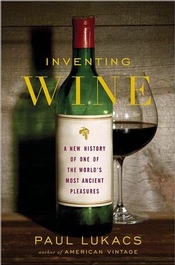In 1989 British wine writer, Hugh Johnson published The Story of Wine, a comprehensive scholarly history of the close relationship of wine and civilization across the centuries. Nearly a quarter century later, American wine writer Paul Lukacs has written Inventing Wine, a book that immediately becomes the new go-to reference for history buffs and those wine fans with a  desire to know the intimate details of how wine evolved.
desire to know the intimate details of how wine evolved.
Lukacs’ inventive idea was to hang the thrust of his comprehensive book, sub-titled “A New History of One of the World’s Most Ancient Pleasures,” on the idea and action of invention. And it makes sense, because all of the major advancements of wine, from the addition of “additives” in ancient rustic Greek and Roman wines to make them taste better, to the highly sophisticated specialty wines of the 21st Century, came from an invention.
Inventing Wine is divided into nine chapters spanning the breadth of civilized human history. Although history does not record the precise period when wine was invented, Lukacs suggests that, no matter its origin, wine “was something mystifying.” The mystery, he says, was closely connected to nature. “In the modern world, man and women attempt to control and master nature when they make wine. But in ancient worlds, the mastery of nature, if conceivable would have been regarded as a sort of blasphemy.”
Lukacs points out that the importance of invention to wine took a giant step with the development of the glass bottle and the use of cork oak bark as a bottle closure. Ancient wines were stored in clay amphorae, lined with pine resin to seal the porosity of the clay, while the mouth of the amphorae was closed with wood plugs wrapped in cloth.
The author keeps the history of wine and associated inventions moving forward in a chronological order. In the Middle Ages, religious orders in France and Germany helped in the development and progress of grape growing and winemaking, such as the positive impact the Cistercian order had on Burgundy in the 12th century, and later, the impact of English tradesmen on the wines of Bordeaux.
Lukacs explains the importance of strategic inventions such as a stronger English bottle and the use of cork that eventually allowed for the development of Champagne. Also emphasized is the quantum leap forward for wine resulting from Louis Pasteur’s explanation of how fermentation works, through an analysis of wine’s chemical composition.
By the advent of “modern wines” in the 19th century, Lukacs maintains that two things separated wine made before the 1800s and wine made since, “The first was the chasm that divided aesthetically conceived wine from vin ordinaire; the second the fraud that pervaded all wine’s trade and commerce.” He holds that by the late 19th century (the century that Lukacs says was wine’s first Golden Age), wine took on a “cultural recognition…as something possessing intrinsic worth.”
Perhaps the book’s most provocative chapter (or at least chapter title and subtitle) is, “Crises and Catastrophies, a Century of Cheapening.” The crisis was the “insinuation of phylloxera” in the late 19th century and the grab-bag of suggested “cures,” such as the use of “Mozambique Oil,” a fish oil cure that Lukacs says “turned out to be a useless hoax.” Then, when the phylloxera crisis had past, unscrupulous merchants were responsible for the “cheapening” by selling vast quantities of new cheap wines “as something more prestigious.”
The presence of Prohibition, America’s disastrous social experiment that lasted from 1920 to 1933, was also responsible for dumping cheap wine on the market. However, after WWII,  Lukacs says that Europe entered “Wine’s Second Golden Age,” a time when varietal wines emerged on the wine scene from such distant places as California and Australia.
Lukacs says that Europe entered “Wine’s Second Golden Age,” a time when varietal wines emerged on the wine scene from such distant places as California and Australia.
But perhaps it is in the chapter “Visions and Varietals,” a focus on the journey and arrival of wine in the New World, that today’s wine collector and drinker will find the most relevance in Lukacs’ book. And for those wine drinkers of a certain age who remember “Cliff Notes,” there is a fourteen-page pause midway through the book, of selected photos from a Neolithic wine jar to photos of Max Schubert, Maynard Amerine and Nicolas Catena, all giants of wine in their respective countries of Australia, United States and Argentina–but also the world.
Inventing Wine is a dense and fascinating account of the inventions that helped make wine what it is today, one that will appeal to the history buff and wine lover alike.
Inventing Wine: A New History of One of the World’s Most Ancient Pleasures
Paul Lukacs
W.W. Norton & Company
350 pages
Hardcover, $28.95
6
